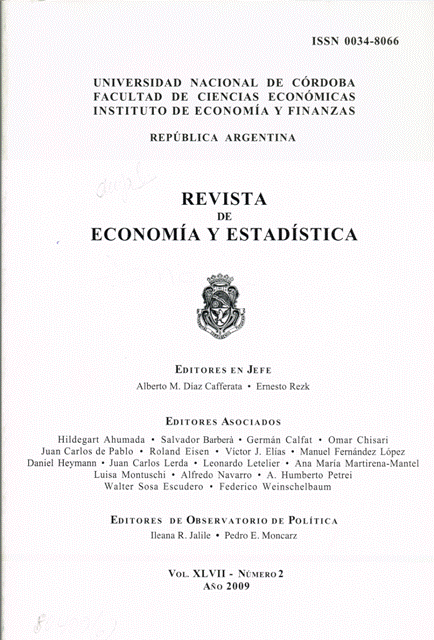Historical Sketch of Agriculture in Argentina up to the End of the 19th Century and the Beginning of the 20th Century. Emphasis on the Characterisation of the Agricultural Producer.
DOI:
https://doi.org/10.55444/2451.7321.2009.v47.n2.3947Keywords:
history, agriculture, Argentina, agricultural coloniesAbstract
In this historical sketch of the agricultural development in Argentina there are found -in relation to the political-institutional framework- three periods: the "Hispánico", the "Las Provincias del Río de la Plata" and the "Organización Nacional, en adelante", noting the main features of each. There are also two colonizing "waves", the "Spanish colonization", founder of the former provincial capitals of Argentina, where begins the significance of the agriculture as is in the present territory of Argentina. The "second colonization" -in the last period- is the concrete foundation of agricultural colonies, giving rise to most of the existing cities and towns in the provinces of Santa Fe, Entre Rios, Cordoba and Buenos Aires, to a much lesser extent; protagonist of the great agricultural development of the country. The farmer in this latter period was a businessman who carried out since its inception almost entirely commercial agriculture, a feature that was deepened with time, that is, the producer purchased inputs in the market and produced for the market.
Downloads
References
Arcondo, Aníbal (1996), En el reino de Ceres. La expansión agraria en Córdoba. 1870-1914, Editorial U.N.C. - F.C.E., Córdoba.
Bidabehere, Fernando A. (1930), Bolsas y Mercados de Comercio en la República Argentina, Talleres Gráficos Argentinos L. J. ROSSO, Buenos Aires.
Cortés Conde, Roberto (1979), El Progreso Argentino 1880-1914, Editorial Sudamericana, Buenos Aires.
Cortés Conde, Roberto (2005), La Economía Política de la Argentina en el siglo XX, Edhasa, Buenos Aires.
De Marco,Miguel Ángel (2008), “Carlos Casado del Alisal, en el Centenario de Casilda”, Revista de la Bolsa de Comercio de Rosario, AñoXCVIII – 1504/ Abril.
Díaz Alejandro, Carlos F. (1975), Ensayos sobre la historia económica argentina, Amorrortu Editores, Buenos Aires.
Gallo, Ezequiel (2004), La Pampa Gringa. La colonización agrícola en Santa Fé (1870-1895), Edhasa, Buenos Aires.
Gallo, Ezequiel y Roberto Cortés Conde (1986), La República Conservadora, Hyspamérica Ediciones Argentina S.A., Buenos Aires.
Giberti, Horacio, C. E. (1964), El desarrollo agrario argentino. Estudio de la región pampeana, EUDEBA, Editorial Universitario de Buenos Aires, Buenos Aires.
Giménez, Ovidio (1971), “Historia del cultivo del trigo en el país”, en Temas de economía libre, Talleres Gráficos de la Compañía General Fabril Financiera S.A., Buenos Aires.
Girbal de Blacha, Noemí M. (1982), Historia de la Agricultura Argentina a fines del Siglo XIX (1890 – 1900), Fundación para la educación, la ciencia y la cultura, Buenos Aires.
Moreyra, Beatriz I. (1992), La producción agropecuaria cordobesa 1880-1930, Centro de Estudios Históricos, Córdoba.
Moyano Aliaga, Alejandro (1992 ), “Los fundadores de Córdoba: su origen y radicación en el medio”, ESTIRPE, Revista de Genealogía, Córdoba.
Resolución de la Academia Nacional de la historia sobre la primera colonia agrícola que se creo en la Republica Argentina. Trascripción digital disponible: http://www.esperanza.gov.ar/ctroestudios/fundaciondeesperanza/dictamen.htm (Dic-2008)
Scobie, James R. (1968), Revolución En Las Pampas. Historia social del trigo argentino. 1860-1910, Solar/Hachette, Buenos Aires.
Tejerina Carreras, Ignacio G. (2007) “La Argentina Fundacional”. Ponencia aprobada en el Congreso de Institutos de Cultura Hispánica de la Argentina, Santa Fe, Octubre.
Zeballos, Estanislao S. (1896), La Concurrencia Universal y la Agricultura en ambas Américas. Informe presentado al excelentísimo señor Ministro de Relaciones Exteriores de la República Argentina, Dr. D. Eduardo Costa, Segunda Edición; Imprenta, Litografía y Encuadernación de Jacobo Peuser, Buenos Aires.
Downloads
Published
Issue
Section
License
Copyright (c) 2009 Rinaldo Antonio Colomé

This work is licensed under a Creative Commons Attribution-NonCommercial-NoDerivatives 4.0 International License.
Authors who have publications with this journal agree to the following terms:
Authors retain their copyright and grant the journal the right of first publication of their work, which is simultaneously subject to the Creative Commons Attribution-NonCommercial-NoDerivatives 4.0 International License that allows third parties to share the work provided that its author and first publication in this journal are indicated.
Authors may adopt other non-exclusive licensing arrangements for distribution of the published version of the work (e.g. depositing it in an institutional telematic archive or publishing it in a monographic volume) as long as the initial publication in this journal is indicated.
Authors are allowed and encouraged to disseminate their work via the Internet (e.g. in institutional telematic archives or on their website) before and during the submission process, which can lead to interesting exchanges and increase citations of the published work. (See The Open Access Effect)










